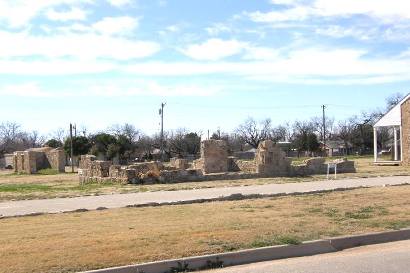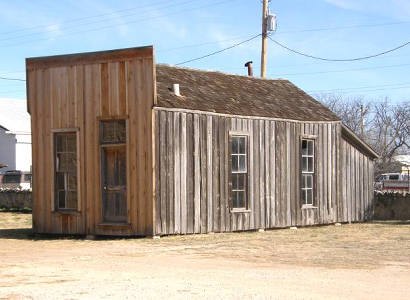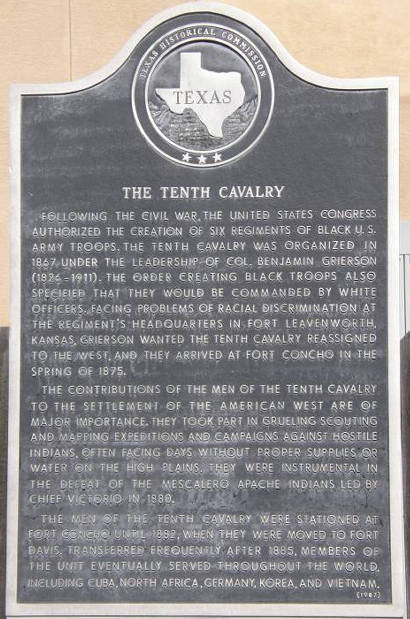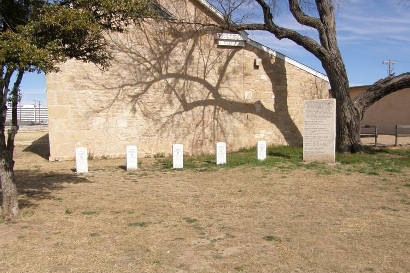|
|
The best preserved
of the chain of forts across Texas.
Twenty-three buildings on 40 acres make up this National Historic
Landmark.
San
Angelo Hotels |
|
|
Photo courtesy Lou Ann Herda |
Historical Marker:
Fort Concho
The center of a
line of forts extending from the northeastern border of Texas to El
Paso. Was also northern point of southern chain of forts extending
to Rio Grande, thence along that river to its mouth.
Established 1867 (at then junction of Butterfield Trail, Goodnight
Trail and road to San Antonio)
by 4th Cavalry under Capt. George G. Huntt to protect frontier. By
March 1, 1870, fort buildings were (in order of their construction)
a commissary and quartermaster storehouse, hospital, five officers
quarters, a magazine and two barracks-- all built of sandstone.
Among those who commanded post were: Gen. Wm. R. Shafter (later major
general of volunteers, Spanish-American
War; commanded troops at capture of Santiago de Cuba, July 1898);
Maj. John P. Hatch (at one time fort was named in his honor); Gen.
Wesley Merritt (first commander of Fort
Davis after Civil War; was later superintendent of U. S. Military
Academy at West Point); Gen. Ranald Slidell Mackenzie (who led attacks,
from this and other forts, credited with defeat of Indian resistance
in southwest); and Gen.
Benjamin H. Grierson, commander of Negro
troops of 10th Cavalry. On June 20, 1889, fort was abandoned as
a military post and property passed into private ownership.
(1970) |
 |
Fort
Concho Stories:
The
Chilled Catfish of Concho County by Mike Cox (From "Texas
Tales" Column)
In the days before instantly-available color weather radar, Isaac
Cline’s story sounded like a Texas-size whopper. Cline had been
assigned to Fort Concho in the spring of 1885 as the officer in
charge of the Army’s Signal Service station. He oversaw the West
Texas cavalry post’s telegraph service, which constituted the only
real-time link to the outside world from that part of the state.
He also took daily weather observations. Read
full article
Dead
Ellis by Mike Cox (From "Texas Tales" Column)
"... The military abandoned Fort Concho in 1889, the last company
of soldiers marching off to San Antonio. The military reservation
became private property and the hospital was converted into a rooming
house. Later, it became a hay barn.
In 1911, lightning sparked a fire that heavily damaged the building,
leaving it a stone shell. Eighteen years later, the rest of the
structure was razed.
But like “Dead” Ellis, the building came back to life. Following
an extensive archaeological investigation, the building was rebuilt
to its original specifications in 1986-1987. Now it and most of
the other structures at the fort are a National Historic Site.
And docents guiding tours of the reconstructed hospital still tell
the story of “Dead” Ellis." Read
full article
Thirsty
by Mike Cox (From "Texas Tales" Column)
"Fort Concho, established along the Concho River in 1867, guarded
that part of the frontier for more than 20 years. Comanche and Kiowa
Indians posed a definite threat to the soldiers stationed there,
especially during the post’s earlier years. But the soldiers faced
a deadlier foe – bad water.
In October 1870, the post surgeon reported 35 cases of typhoid fever,
69 cases of acute diarrhea and dysentery and 21 cases identified
as “continued and remittent fever.” Six soldiers died that month
from one or another of those ailments.
The doctor may or may not have had a microscope at his disposal,
but he knew the culprit: Tainted water. A year before, he had reported
that the North Concho River at that time consisted of only shallow,
stagnant pools. The main arm of the river, he said, had been contaminated
with putrefying animal matter, including buffalo carcasses. River
water smelled bad and tasted worse.
Indeed, when the river was low it teemed with harmful microbes,
the invisible life forms that could kill a man as surely as a red-painted
Comanche arrow or a spiraling .50 caliber slug from a Spencer carbine."
Read full article
The
Skunk War by Mike Cox
"Col. Benjamin H. Grierson led one of the Civil War's most
impressive cavalry campaigns and would see more combat as a cavalry
officer in West Texas, but sometimes even an experienced officer
gets outmaneuvered." Read
full article
Camp
Elizabeth - Fort Concho's outpost
Elijah
Cox by Murray Montgomery
Fighting Indians on the Texas Frontier
San
Angelo Hotels Book Here
|
Fort
Concho Photo Gallery
|
Fort Concho Old
Barracks, Buildt 1867
Photo courtesy Barclay
Gibson, 2010 |
 |
 |
Historical
Marker Text
The Tenth Cavalry
Following the Civil War, the United States Congress
authorized the creation of six regiments of black U.S. Army troops.
The Tenth Cavalry was organized in 1867 under the leadership of Col.
Benjamin Grierson (1826-1911). The order creating black troops
also specified that they would be commanded by white officers. Facing
problems of racial discrimination at the regiment's headquarters in
Fort Leavenworth, Kansas, Grierson
wanted the Tenth Cavalry reassigned to the West, and they arrived
at Fort Concho in the Spring of 1875.
The contributions of the men of the Tenth Cavalry to the settlement
of the American West are of major importance. They took part in grueling
scouting and mapping expeditions and campaigns against hostile Indians,
often facing days without proper supplies or water on the high plains.
They were instrumental in the defeat of the Mescalero Apache Indians
led by Chief Victorio in 1880.
The men of the Tenth Cavalry were stationed at Fort Concho until 1882,
when they were moved to Fort
Davis. Transferred frequently after 1885, members of the unit
eventually served throughout the world, including Cuba, North Africa,
Germany, Korea, and Vietnam.
(1987) |
 |
Fort Concho National
Historic Lankmark Plaque
Photo courtesy Barclay
Gibson, 2010 |
|
|
